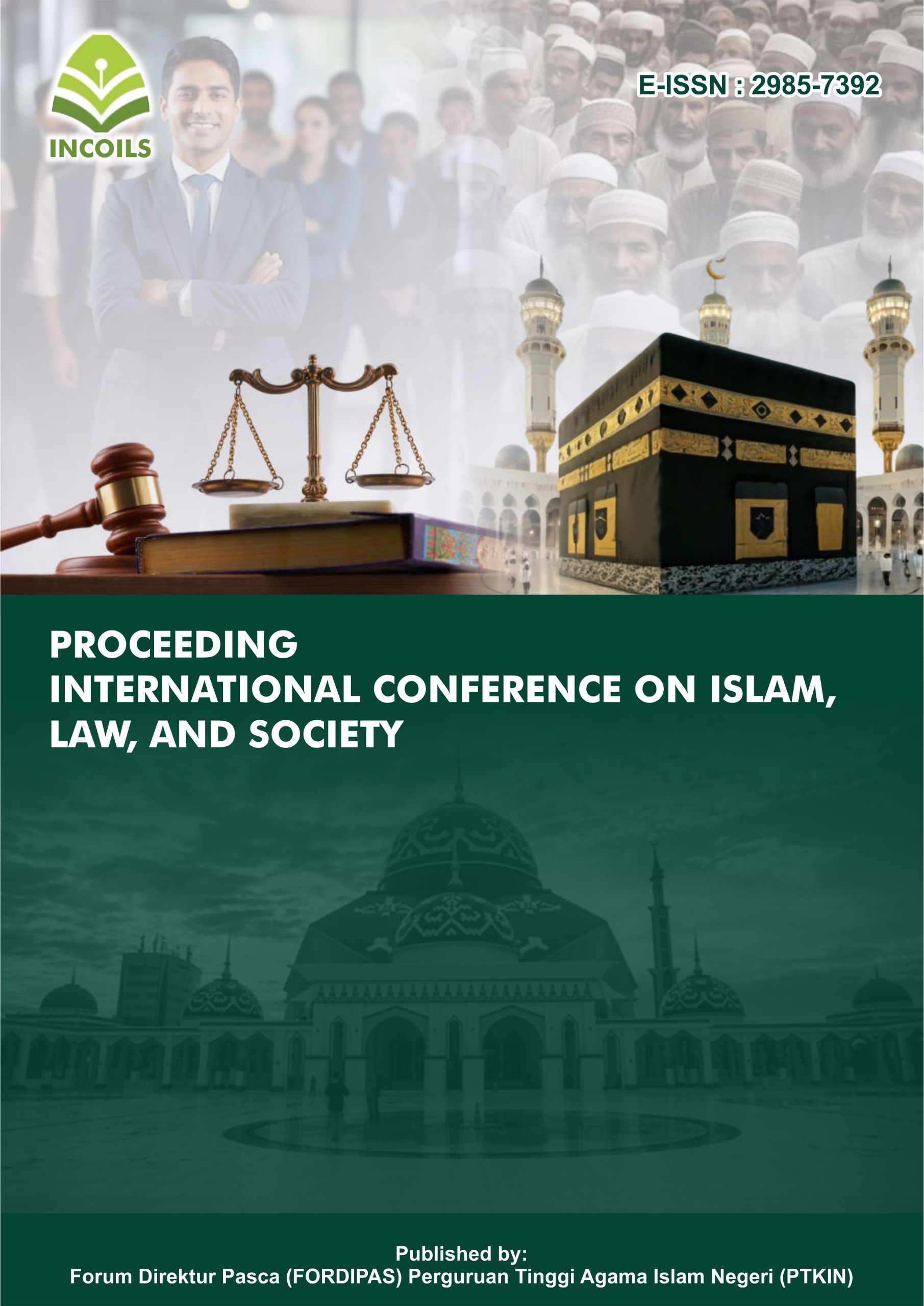Qouliyah-Kauniyah Verse Relation (Integration of the Qur'an with Science in the Discourse of Interpretation)
DOI:
https://doi.org/10.70062/incoils.v3i1.137Abstract
The birth of tafsir with the pattern of 'Ilmi' tafsir is proof that the study of science and the Qur'an cannot be separated and will continue to develop, this is clear evidence of the relationship between the kauniyah verse and the qauliyah verse. This research seeks to examine the nature of the verse qauliyah and verse kauniyah, how both are fused, and also how the pattern of scientific development produces tafsir ilmi which is not far from the rules of interpretation that have been set by the mufassirun. This research method uses a qualitative method with a literature research approach. This study concludes that the relationship between the Qur'an and science can be seen through the many scientific truths described in the Qur'an that show the integration between the two. Mufasirs try to combine the findings of scientific theories with the exposure of the verses of the Qur'an. However, many interpreters are eventually trapped by the element of subjectivity in the application of interpretation so that it seems that the verse of the Qur'an is used to legitimize the scientific theory. This is certainly not in line with the standard rules of tafsir science. For this reason, some principles of interpretation are needed, so that the element of subjectivity of interpretation can be avoided. Additional principles in addition to the main principles that have been standardized required for a mufassir, there are other additions, namely: mastery of the right language, scientific discoveries do not contradict the verses of the Qur'an by paying attention to the context between words or verses, the nature of scientific discoveries does not exceed the editorial content of the verses.
References
Abdullah, M. Amin dkk. Integrasi Sains-Islam Mempertemukan Epistomologi Islam Dan Sains. Yogyakarta: Pilar Religia, 2004.
Abuddinnata, dkk. Propectus UIN Syarif Hidayatullah. Jakarta: UIN Jakarta Press, 2006.
Al-’Aqqad, ’Abbas Mahmud. Al-Falsafah Al-Qur’aniyyah. Kairo: Dar al Hilal, tt.
Al-Asfahaniy, Al-Raghib. Mufradat Gharib Al-Qur’an. Mesir: Al-Halabiy, n.d.
“Al-Qur’an Dan Lahirnya Sains Teistik | TSAQAFAH.” Accessed October 12, 2023. https://ejournal.unida.gontor.ac.id/index.php/tsaqafah/article/view/756.
Al-Syinqithy, Muhammad al-Amin bin Muhammad Aal-Mukhtar Al-Jakni. Adhwaul Bayan Fi> Idhahil Quran Bil Quran. Beirut: Dar al fikr, 1410.
Al-Zahabiy, Husain. Al-Tafsi>r Wa Al-Mufassiru>n. Mesir: Dar Al-Kitab Al-’Arabiy, 1963.
al-Zarkasy, Imam. Al-Burha>n Fi> ’Ulu>m Al-Qur’an. 1st ed. Kairo: al Halabiy, 1957.
“’Anil Islam: Jurnal Kebudayaan Dan Ilmu Keislaman.” Accessed October 12, 2023. https://jurnal.instika.ac.id/index.php/AnilIslam/index.
Arnentis, Arnentis, and Evi Suryawati. “Analysis of Understanding Ond Strengthening Of Character Students Integration through Passages Qauliyah Course Materials on the Development of Animal.” Proceeding Biology Education Conference: Biology, Science, Enviromental, and Learning 12, no. 1 (January 1, 2016): 602–6.
As-SyahatAbdullah. Tafsir Ayat Kauniyah. Kairo: dar al i’tisham, 1400.
Banna, Ḥasan al-. Muqaddimah Fi> ‘Ilm al-Tafsi>r. Mesir: Da>r al-Ma’a>rif, 1975.
Hisyam, Abdulllah bin. Audhahul Masa>lik Ila Alfiyat Ibn Malik. Beirut: Dar Ibn Hazm, 1429.
Jauhari, Thanthawi. Al-Jawa>hir Fi> Tafsi>r Al-Qur’an. Jilid 1. Kairo: al Halabiy, 1350.
Majma`ul Lughah Al-`Arabiah. Al-Mu`jam Al-Wasith. Mesir: Majma`ul Lughah Al-`Arabiah, 1429.
Matondang, Husnel Anwar, and Sabriandi Erdian. “Alqur’an Dan Sains (Suatu Sudut Pandang Terhadap Legalitas Penafsiran Sains Atas Al-Qur’an).” Journal Polingua: Scientific Journal of Linguistics, Literature and Language Education 2, no. 1 (2013): 14–24. https://doi.org/10.30630/polingua.v2i1.53.
Mufid, Fathul. “Open Journal Systems.” Accessed October 12, 2023. https://doi.org/10.21043/equilibrium.v1i1.200.
Muhammad, Ahsin Sakho. Keberkahan Al-Qur’an Memahami Tema-Tema Penting Kehidupan Dalam Terang Kitab Suci. Jakarta: Qaf, 2017.
Purwanto, Agus. Ayat-Ayat Semesta. Jakarta: Mizan, 2008.
Ridha, Muhammad Rasyid. Tafsir Al-Manar. Mesir: Dar Al-Manar, 1367.
Ristanto, Zakir Naik, alaih bahasa Dani. The Qur’an & Modern Sciense. Solo: Aqwam, 2019.
Rosydi, Abdul Wahab. Sains Dalam Sejarah Peradaban Islam Merunut Akar-Akar Sains Islam Sebagai Dasar Upaya Pengembangan Sains Dan Teknologi Di PTKIN. Malang: UIN Malang, n.d.
Shihab, M. Qurais. Wawasan Al-Qur’an Tafsir Maudhu’i Atas Pelbagai Persoalan Umat. Jakarta: Mizan, 2007.
Shihab, M. Quraish. Membumikan Al-Qur’an. Jakarta: Mizan, 1992.
“Subjektivitas Dalam Penafsiran Al-Quran: Fenomena Tafsir Bercorak Sektarian | Jurnal At-Tibyan: Jurnal Ilmu Alqur’an Dan Tafsir.” Accessed October 12, 2023. https://journal.iainlangsa.ac.id/index.php/tibyan/article/view/483.
Susilawati, Susilawati. “Menuju Integrasi Ilmu-Ilmu Keislaman Dengan Ilmu-Ilmu Umum (Integratif Antara Kajian Yang Bersumber Ayat-Ayat Qauliyah Dan Ayat-Ayat Kauniyah).” Cross-Border 5, no. 1 (September 19, 2022): 939–54.
Syaltut, Mahmud. Tafsi>r Al-Qur’an Al-Azhi>m. II. Mesir: Dar al-Qalam, n.d.
“Tafsir Ayat Kauniyah | Rusydi | Al Qalam: Jurnal Ilmiah Keagamaan Dan Kemasyarakatan.” Accessed October 12, 2023. https://jurnal.stiq-amuntai.ac.id/index.php/al-qalam/article/view/56.
Utsaimin, Muhammad bin Shalih. Al-Qaul Al-Mufi>d `’Ala> al-Kita>b Tauhid,. Damaskus: Muassasatu ar-Risalah An-Nasyirun, 1431.
Downloads
Published
How to Cite
Issue
Section
License

This work is licensed under a Creative Commons Attribution-ShareAlike 4.0 International License.







